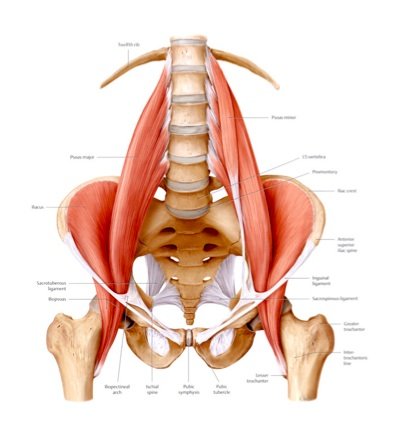Why is everyone talking about hip flexors?
Hip flexors, anterior hip, psoas, all of these are terms you may hear referencing the iliopsoas or hip flexor group. More specifically this refers to iliacus and psoas, the largest and most powerful hip flexors.
These muscles have attachments on the top of your femur, the inside of your pelvis and your spine. Yea, literally on your spine. This muscle group is quite robust and acts powerfully on the lumbar spine, pelvis and femur itself. Primarily responsible for hip flexion, bringing your knee toward your chest, you can imagine this group is more often than not, in a shortened position. Desk warriors, cyclists and folks who commute find themselves in hip flexion a lot. In my clinical practice, I find a vast majority of my clients present with approximately 0-5 degrees of true hip extension. When I say true hip extension, I mean this ROM is coming from your hip, not your low back arching into extension. All humans should be shooting for around 10-15 degrees of true hip extension. Without this mobility, you can expect to experience some low back pain, knee pain, IT band pain among many other possible pain sites. Lack of hip extension mobility seriously limits your ability to utilize glute max optimally. That's a big ass problem.
Imagine only being able to move your elbow 50 degrees. There would be no doubt that a problem is on the horizon. That said, most of us are walking around missing a lot of our hip extension mobility and we are none the wiser. What we don't know can hurt us.
Not only will restrictions in your hip flexors length cause mechanical changes down the kinetic chain you can also experience referral pains from the muscle itself. This is very common and often misunderstood as its referral pattern is usually to the low back or anterior hip or thigh.
Stretching of your hip flexor is a great idea for anyone who is in a flexed hip position often. We have spoken about ways to stretch your hips before but if you need a reminder I will link a video to my favorite stretch below. Sometimes you need more than stretching to address a stiff psoas. Manual release techniques are a great way to achieve pain relief here. This could be done with the goal of reducing referral pain in the low back you suspect is coming from the hip flexors. Below you will find a few of my favorite ways to release my hip flexors. Think of these release techniques in the same way you think of foam rolling your quads of glutes.


